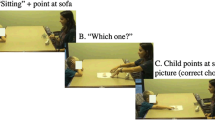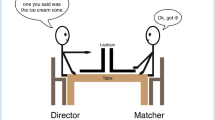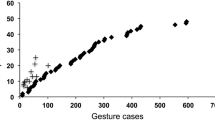Abstract
Following unsuccessful attempts to teach a 6-year-old, mute autistic-retarded boy to follow simple verbal instructions, an effort, described in the case study, was made to train the child to comply with gestural commands. It is reported that the latter part of the program worked well, resulting in the boy's ability to follow instructions to stand up, sit down, turn around, turn an object over, go to another person, and give an object to someone else. Also, other activities began to come under gestural control, and the child learned to instruct a person to stand up. It is further suggested that the acquired behavior did not require much time or effort to establish (24 one-hour sessions, none of which totally devoted to gestural training). The results and potentialities of the described training procedure are discussed in light of recent findings by other researchers.
Similar content being viewed by others
References
Boatman, M., & Szurek, S. A clinical study of childhood schizophrenia. In D. D. Jackson (Ed.),The etiology of schizophrenia, New York: Basic Books, 1960.
Churchill, D. W. Effects of success and failure in psychotic children.Archives of General Psychiatry, 1971,25, 208–214.
Churchill, D. W. The relation of infantile early autism and early childhood schizophrenia to developmental language disorders of childhood.Journal of Autism and Childhood Schizophrenia, 1972,2, 182–197.
Creedon, M. P. Language development in nonverbal autistic children using a simultaneous communication system. Paper presented at the Society for Research in Child Development Meeting, Philadelphia, March 1973.
Deslauriers, A. M., & Carlson, C. F.Your child is asleep: Early infantile autism. Homewood, Ill.: Dorsey, 1969.
Ferster, C. B., & DeMeyer, M. A method for the experimental analysis of the behavior of autistic children.American Journal of Orthopsychiatry, 1962,32, 89–98.
Gardner, A. R., & Gardner, B. T. Teaching sign language to a chimpanzee.Science, 1969,165, 423–427.
Hermelin, B., & O'Connor, N.Psychological experiments with autistic children. Oxford: Pergamon, 1970.
Hutt, S. J., Hutt, C., Lee, D., & Ounsted, C. A behavioral and electroencephalographic study of autistic children.Journal of Psychiatric Research, 1965,3, 181–197.
Jacobson, L. I., Bernai, G., & Lopez, G. N. Effects of behavioral training on the functioning of a profoundly retarded microcephalic teenager with cerebral palsy and without language or verbal comprehension.Behavior Research and Therapy, 1973,11, 143–145.
Klima, E. S., & Bellugi, V. The signs of language in child and chimpanzee. In T. M. Alloway, L. Krames, & P. Pliner (Eds.),Communication and affect: A comparative approach. New York: Academic Press, 1972.
Lovaas, O. I., Berberich, J. P., Perloff, B. F., & Schaeffer, B. Acquisition of imitative speech by schizophrenic children.Science, 1966,151, 705–707.
Lovaas, O. I., Koegel, R., Simmons, J. Q., & Long, J. S. Some generalization and follow-up measures on autistic children in behavior therapy.Journal of Applied Behavior Analysis, 1973,6, 131–166.
Lovaas, O. I., Schreibman, L., Koegel, R., & Rehm, R. Selective responding by autistic children to multiple sensory input.Journal of Abnormal Psychology, 1971,77, 211–222.
MacNamara, J. Cognitive basis of language learning in infants.Psychological Review, 1972,79, 1–13.
Metz, J. R. Conditioning generalized imitation in autistic children.Journal of Experimental Child Psychology, 1965,2, 389–399.
Rutter, M. Behavioral and cognitive characteristics of a series of psychotic children. In J. K. Wing (Ed.),Early childhood autism: Clinical, educational and social aspects. Oxford: Pergamon, 1966.
Rutter, M. Concepts of autism. A review of research.Journal of Child Psychology and Psychiatry, 1968,9, 1–25.
Skinner, B. F. “Superstition” in the pigeon.Journal of Experimental Psychology, 1948,38, 168–172.
Wing, J. K. Diagnosis, epidemiology, aetiology. In J. K. Wing (Ed.),Early childhood autism: Clinical, educational and social aspects. Oxford: Pergamon, 1966.
Wolf, M. W., Risley, T., & Mees, H. Application of operant conditioning procedures to the behavior problems of an autistic boy.Behavior Research and Therapy, 1964,1, 305–312.
Author information
Authors and Affiliations
Additional information
We wish to thank the mothers and teachers of the children for their interest and participation. We are also indebted to Cecelia and Gerald Smith for information and assistance, to Stephen Springer for sharing with us his knowledge of sign language, and to Mark Sherman for providing data on gestural vs. auditory control.
Rights and permissions
About this article
Cite this article
Webster, C.D., McPherson, H., Sloman, L. et al. Communicating with an autistic boy by gestures. J Autism Dev Disord 3, 337–346 (1973). https://doi.org/10.1007/BF01538541
Issue Date:
DOI: https://doi.org/10.1007/BF01538541




